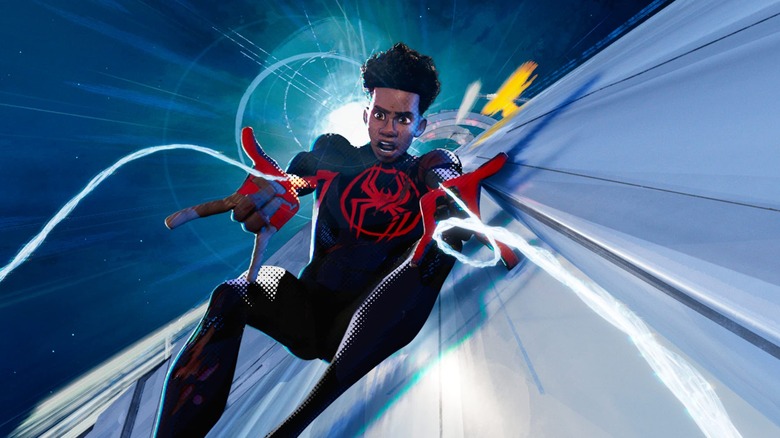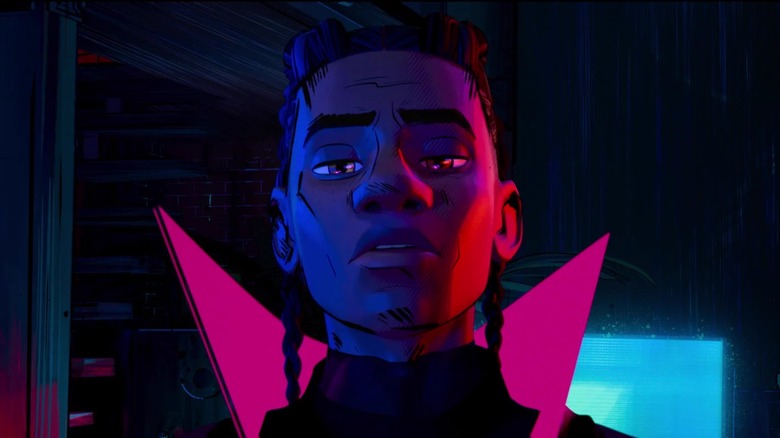Why Is Spider-Man: Across The Spider-Verse's Digital Release Different From The Theatrical Cut?
No, neither your eyes nor your memory have deceived you. This isn't a case of the Mandela Effect waving over moviegoers on a global scale, either. If anyone's feeling like there's a slight amount of gaslighting going on regarding different versions of "Spider-Man: Across the Spider-Verse" — even as the highly-anticipated sequel ended its theatrical run and was made available on digital — it turns out there's an explanation for that. Whether it's a good explanation or not, well, we'll leave that up to you.
/Film previously covered the head-scratching phenomenon of different versions of "Across the Spider-Verse" hitting theaters worldwide, as confused viewers took to social media to post their recollections of certain scenes and moments in the animated film playing out differently compared to others' experiences. While some chalked this up to the filmmakers directly leaning into the whole multiverse angle of it all, the real reason turned out to be far less fun.
Reports revealed that a combination of Sony's punishing work environment and super-producer Phil Lord's infamously indecisive management style combined to create an atmosphere of overwork and overstress for the animators tasked with making these films as visually spectacular as they are. Once public blowback to such revelations reached a fever pitch, fans understandably demanded change moving forward. (On a related note, these sorts of stories are exactly why the ongoing WGA and SAG-AFTRA strikes remain so important to the future of the hardworking artists in this industry.)
That's why it's doubly confusing to hear that changes continued to be made to "Across the Spider-Verse" even after the film's release. This time, differences have been spotted between the theatrical cut and the digital version now available on home media. Social media users quickly compiled a new list of changes, which you can see here. Now, the filmmakers are addressing this situation, too.
Here we go again?
If you're anything like me, the idea of different versions of media existing out there in the ether, forcing viewers to do homework to figure out which one is the "right" one, is nothing but an aggravating experience (outside of director's cuts, of course). That applies twofold with a movie as genuinely fun as "Across the Spider-Verse," which has once again become overshadowed by external controversies that could've easily been avoided in the first place. The latest one focuses on the changes made to the film's digital release, which Phil Lord and Chris Miller are now addressing.
In a new interview with Total Film, the filmmaking duo that served as producers on both "Spider-Verse" films explained why this apparent new version features so many differences from the theatrical cut(s). According to Miller:
"There was an international version that was made almost two months before the movie came out because it had to be translated into different languages and these French censors have to decide what the rating of the movie is in Europe.
The team at [Sony Pictures] Imageworks still had some shots that they felt they could do better for the finished version. So, they cleaned up and tweaked those things."
Now, while slightly differing international cuts are a commonplace practice for the vast majority of blockbusters, what makes this situation so unusual is the idea that the film seems to have been in a constant state of flux — even after release. But as Lord goes on to say, "I think most of the changes are improvements." Of course, many disgruntled fans would contest that, pointing to numerous instances where slight changes in dialogue or animation made for a less rewarding experience. However, there are even more details to parse in this story.
Blame game?
The saga surrounding the various different versions of "Across the Spider-Verse" isn't going away anytime soon, apparently. At the very least, we're now getting more information as to why this trend is continuing well after typical productions picture-locked their final cuts well in advance of release. As more and more fans are finding out, there are unfortunate side effects to the success of even the best animated movies.
If Chris Miller is to be believed, the ongoing changes to the sequel came at the behest of the blue-collar artists on the production:
"Certain crew members — people in the sound department or on the animation team — were like, 'Oh, could we do this instead? Let's do the best possible version we can. Because it's a multiverse movie, it's like there's a multiverse of the movie' — that was really the reasoning behind it. It was trying to make the best possible version that everyone was going to be the proudest of."
Now, it's worth noting that those earlier reports about behind-the-scenes trouble during production pointed the blame squarely at Phil Lord's penchant for requiring constant rewrites and on-the-fly adjustments to entire scenes at the last minute, while Miller remained curiously absent from much of the post-production process. With that in mind, it's hard to ignore the fact that these quotes are subtly shifting the responsibility away from both Lord and Miller and onto the overworked crew themselves. But short of another damning exposé, it's possible that this is the only official word we'll ever receive about these changes on the digital release.
The third film in this trilogy, "Spider-Man: Beyond the Spider-Verse," currently has no official release date.


